Primary Sources
Primary Sources

Teachers, need a primary source to create a lesson in the classroom? Students, need a source for a research project?
Here, we've listed the primary sources featured in our Unit Plans. Click on a primary source to go to its page, where you may find additional images, transcriptions of the text, a citation guide for including the source in a bibliography, or ways to purchase copies of the source for the classroom.
HSP's collections are not limited to the primary sources listed here. To see all that HSP has to offer, come visit us or explore our collection online through the Digitial Library and the Discover online catalog.
Some sources have handwriting that is difficult to read. If you need help decoding handwriting, check out this guide from Ancestry.
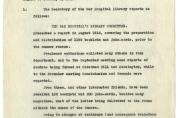 Details the work done by the National League for Woman's Services to combat the flu epidemic. |
 Report submitted to the Honorable J. |
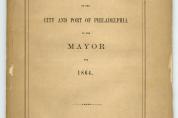 Cover of a report on health issues in the city of Philadelphia, including its port. |
 The diaries of Elizabeth Sandwith Drinker highlight the life of a Quaker woman living in Philadelphia in the late 1700s and early 1800s. Between 1758 and 1807, Drinker fastidiously wrote in her journals, usually about her family and their health and well being. Occassionaly, she also detailed medical practices and her own moral standards. She discussed major events insofar as they affected her family, such as the Revolutionary War and the 1793 Yellow Fever outbreak. |
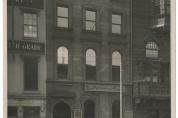 The photographs depict interiors and exteriors of the Emergency Aid of Pennsylvania committee locations. |
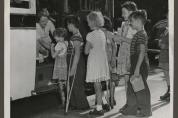 A selection of photographs from the Philadelphia Record newspaper depicting activites of the Philadelphia Society for Crippled Children, circa 1944-1945. |
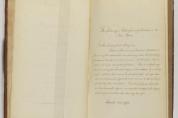 From the title page: "Proceedings of the Committee, Appointed on the 14th of September, 1793, by the Citizens of Philadelphia, the Northern Liberties, and the District of Southwark to Attend to and Alleviate the Suffering of the Afflicted with the Malignant Fever Prevalent in the City and Its Vicinity with an Appendix." |
 Bush Hill Mansion was built 1737 by William Hamilton Esquire. After his death, it was the country seat of his son, James Hamilton. |
 The Dead House, on the banks of the Schuylkill River, held boides of the deceased during the Yellow Fever epidemic of 1793 |
 A large parade for the Fourth Liberty Loan in Philadelphia on September 28, 1918, was blamed for spreading influenza throughout the city and its environs, causing Philadelphia’s experience of the influenza epidemic to be uniquely catastrophic.
|
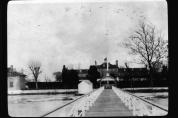 A photograph featuring the entrance to Lazaretto Quarantine Station. |
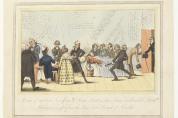 At the center of this 1820 cartoon, a man lying face-down on a bed vomits into a bucket, groaning "drunk drunk oh lord." He is surrounded by doctors and officials from the New York Board of Health, who are convinced that he has yellow fever and who ignore the African American servant woman, standing to the left of the bedside, who explains that the patient is merely drunk. |
- 1 of 22
- next ›
